Lewin Benjamin (ed.) Genes IX
Подождите немного. Документ загружается.

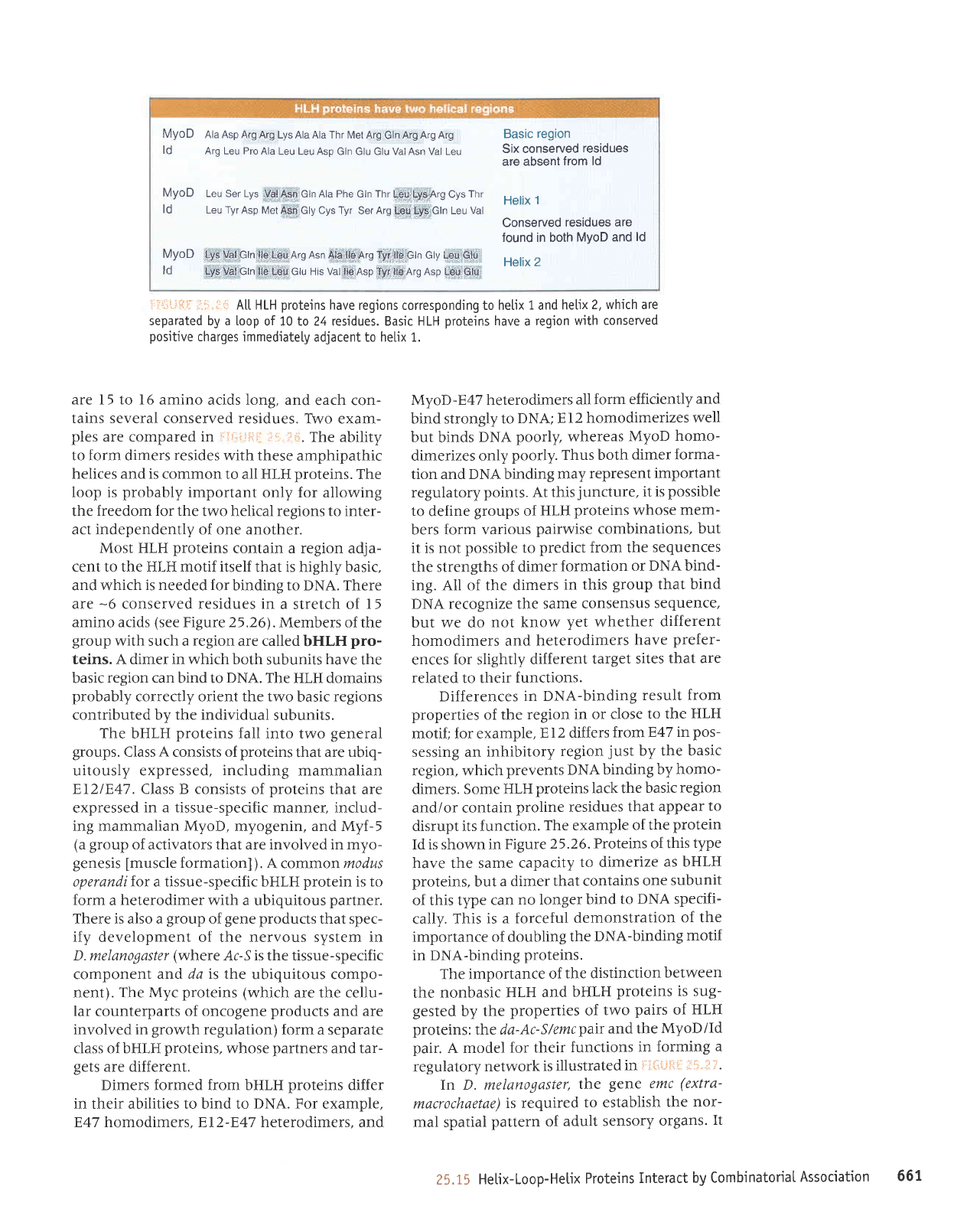
MyoD
nta nsp nrg
Arg Lys Ala Ala Thr l\4et Arg
cln Arg
Arg Arg
ld
Arg
Leu
Pro
Ala Leu Leu
Asp Gln Glu Glu ValAsn Val Le-
MyoD
Leu Ser Lys :Valfuri
Gln Ala Phe cln Thr
Leu Lys
Arg
Cys
Thr
ld
LeuTyrAspMetAStclyCysTyr
SerArgtdtli:yfGtn Leuvat
Myo D
rye Vai c
tn,llii:
ler;l
nrg nsn
AiLir,ilr!
Arg
lii
r|e
crn
G ty
-Leu
Gtll
ld
Lis
Va!,:e
tn
lle'iie-u,
ctu His val
rli€t
Asp
li4ili4:Arg
Asp
lieu
Glu
Basic
region
Six conserved
residues
are absent
from ld
Helix
1
Conserved
residues are
Jound
in
both MyoD
and
ld
Helix 2
iiirijEi.
:i:,i:ir
At[ HLH
proteins
have
reg'ions corresponding to hetix
l
and
helix
2, which are
separated by a toop
of 10 to 24 residues. Basic HLH
proteins
have a
region with
conserved
positive
charges immediatety
adjacent to helix L.
are l5 to l6 amino
acids long, and
each con-
tains several conserved residues.
Ttvo exam-
ples
are compared in
ljL:;i,iiii
ill.ii{:.
The ability
to form dimers
resides
with these
amphipathic
helices and is common
to all HLH
proteins.
The
loop is
probably
important
only for allowing
the
freedom for the
two helical regions to inter-
act independently of one another.
Most HLH
proteins
contain a region adja-
cent to the HLH motif itself
that is highly basic,
and which
is needed for
binding to DNA. There
are
-6
conserved residues in
a stretch of
I
5
amino acids
(see
Figure 25.26).
Members of the
group
with such a
region
are called
bHLH
pro-
teins. A dimer in which both
subunits
have
the
basic
region can
bind to
DNA.
The HLH domains
probably
correctly orient the two
basic
regions
contributed by the individual
subunits.
The
bHLH
proteins
fall into two
general
groups.
Class A consists of
proteins
that
are ubiq-
uitously expressed,
including
mammalian
Ef2lE47. Class B consists
of
proteins
that are
expressed
in a tissue-specific
manner, includ-
ing mammalian MyoD, myogenin, and Myf-5
(a
group
of activators that are involved in myo-
genesis
[muscle
formation]
).
A common modus
operandi for a tissue-specific bHLH
protein
is to
form
a
heterodimer
with a ubiquitous
partner.
There is also a
group
of
gene
products
that spec-
ify development of the nervous system in
D. melanogaster
(where
Ac-S is the tissue-specific
component
and da is the
ubiquitous compo-
nenr). The Myc
proteins (which
are the cellu-
lar
counterparts
of oncogene
products
and
are
involved
in
growth
regulation)
form a separate
class of bHLH
proteins,
whose
partners
and tar-
gets
are different.
Dimers formed from bHLH
proteins
differ
in their abilities to bind to
DNA.
For example,
E47 homodimers, EI2-E47 heterodimers, and
MyoD-E47 heterodimers
all form
efficiently
and
bind strongly to
DNA; El2
homodimerizes
well
but
binds
DNA
poorly,
whereas
MyoD
homo-
dimerizes only
poorly. Thus both
dimer forma-
tion and DNA binding
may
represent
important
regulatory
points. At this
juncture,
it is
possible
to
define
groups
of
HLH
proteins
whose
mem-
bers form various
pairwise
combinations,
but
it is not
possible
to
predict
from the
sequences
the strengths of
dimer
formation
or DNAbind-
ing. All of the dimers
in this
group
that bind
DNA recognize the same
consensus
sequence,
but we do
not know
yet
whether
different
homodimers and
heterodimers
have
prefer-
ences
for
slightly
different
target
sites
that are
related to their
functions.
Differences
in DNA-binding
result
from
properties
of the
region
in or close
to the
HLH
motif; f or example,
E
I2 differs
fromB4T
in
pos-
sessing an inhibitory
region
just
by the basic
region, which
prevents DNA
binding by
homo-
dimers.
Some HLH
proteins lack the
basic
region
and/or contain
proline
residues
that
appear
to
disrupt its function.
The
example
of the
protein
Id is shown in
Figure
25.26. Proteins
o{ this
type
have the same
capacity
to dimerize
as bHLH
proteins,
but
a dimer
that contains
one
subunit
of this type
can
no longer
bind to
DNA specifi-
cally. This
is a forceful
demonstration
of the
importance
of doubling
the
DNA-binding
motif
in DNA-binding
proteins.
The importance
of
the distinction
between
the
nonbasic HLH
and
bHLH
proteins is sug-
gested
by the
properties
of
two
pairs
of
HLH
proteins:
tine da-Ac-S/emcpair
and the
MyoD/Id
pair.
A model
for their
functions
in
forming
a
regulatory
network
is illustrated
in
i:i{;t"::-}* ;l*-ll;.
In D. melanlgaster,
the
gene emc
(extra'
macrochaetae)
is required
to establish
the
nor-
mal spatial
pattern
of
adult sensory
organs.
It
2 5. 15
HeLix- Loop-
Hetix
Protei
ns Interact
by Com
bi natoriaI
Association
661
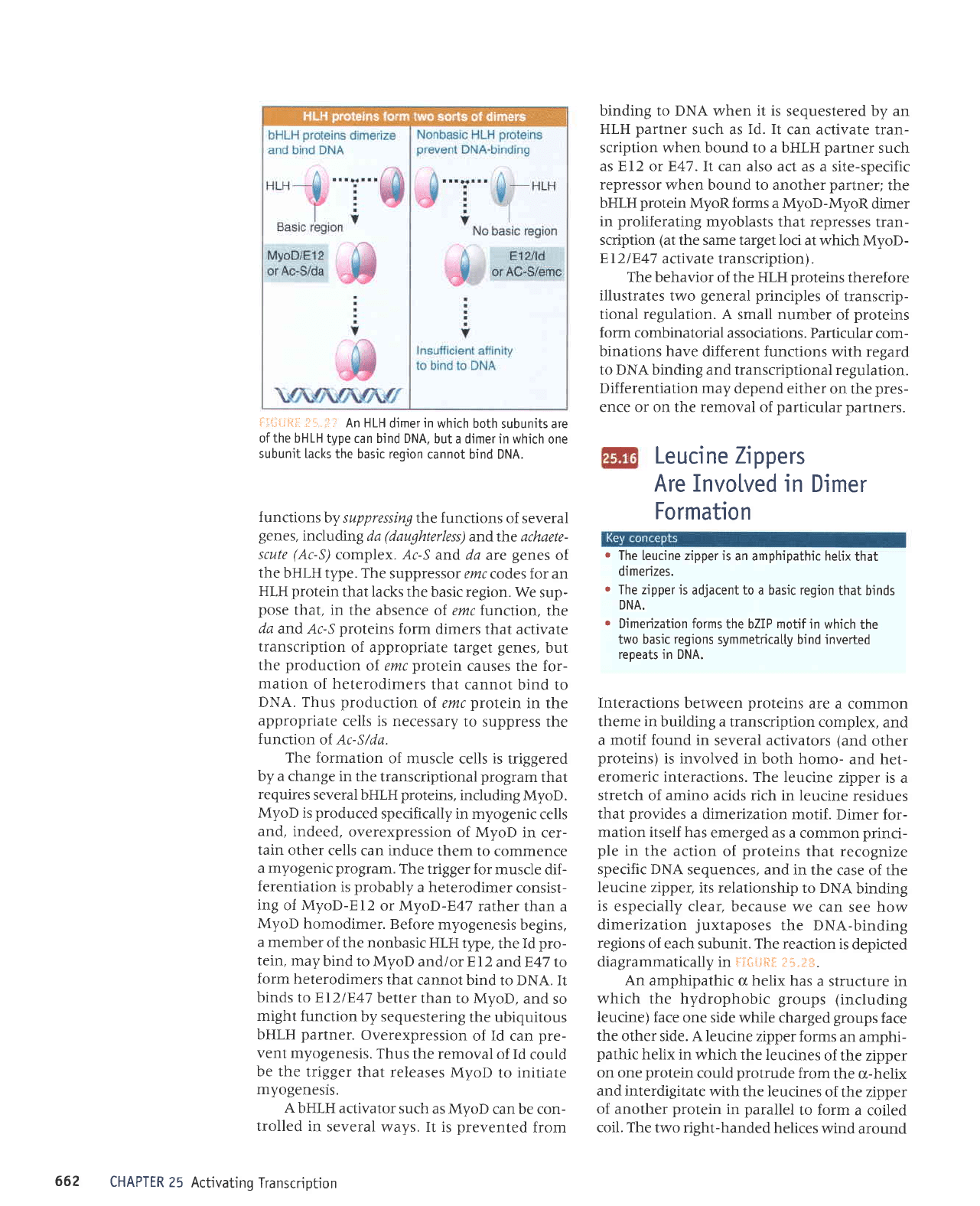
binding to DNA when it is
sequestered by an
HLH
partner
such as
Id. It
can activate tran-
scription when bound to a bHLH
partner
such
as El2 orE47.It can also
act as a site-specific
repressor
when bound to another
partner;
the
bHLH
protein
MyoR forms a MyoD-MyoR
dimer
in
proliferating
myoblasts that represses
tran-
scription
(at
the same target loci
at which MyoD-
El2
lE47 activate transcription).
The behavior
of the
HLH
proteins
therefore
illustrates
two
general principles
of transcrip-
tional regulation. A
small
number
of
proteins
form combinatorial
associations. Particular
com-
binations have
different functions
with regard
to DNA binding and transcriptional
regulation.
Differentiation may
depend either
on the
pres-
ence or on the removal of
particular
partners.
ii,;:-i*.i: ili:.J."r
An HLH
dimer
in
which both
subunits are
ofthe
bHLH type can bind DNA,
but a dimer in which
one
subunit lacks
the basic reqion
cannot bind DNA.
functions
by suppressing the functions
of several
genes,
including
da
(daughterless)
and the achaete-
scute
(Ac-S)
complex. ,4c-S
and da
are
genes
of
the
bHLH type. The
suppressor
emc codes f.or an
HLH protein
that lacks the
basic region. We
sup-
pose
that, in the
absence of. emc function,
the
da
and Ac-S
proteins
form
dimers that activate
transcription
of appropriate
target
genes,
but
the
production
of emc
proLein
causes the for-
mation
of
heterodimers
that cannot
bind to
DNA. Thus production
of. emc
protein
in the
appropriate
cells is necessary
to suppress
the
function
oI Ac-S/da.
The
formation
of muscle
cells is triggered
by a change
in the
transcriptional
program
that
requires
several bHLH
proteins,
including
MyoD.
MyoD
is
produced
specifically
in myogenic
cells
and,
indeed,
overexpression
of MyoD
in cer-
tain
other cells
can induce them
to commence
a myogenic
program.
The trigger for
muscle
dif-
ferentiation
is
probably
a heterodimer
consist-
ing
of MyoD
-El2
or MyoD-847
rather
than a
MyoD
homodimer.
Before
myogenesis
begins,
a member
of
the nonbasic HLH
type,
the Id
pro-
tein,
may
bind to MyoD
and/or E l2
and E47 to
form
heterodimers
that
cannot
bind to DNA. It
binds
to EI2lE47
beter
than ro
MyoD, and
so
might
function
by sequestering
the ubiquitous
bHLH
partner.
Overexpression
of Id can
pre-
vent
myogenesis.
Thus
the removal
of Id
could
be the
trigger
that releases
MyoD
to
initiate
myogenesls.
AbHLH
activator
such
as MyoD
can be con-
trolled
in several
wavs. It is
prevented
from
Activating
Transcription
Leucine Zippers
Are Involved in
Dimer
Formation
.
The leucine zipper is
an amphipathic hetix
that
dimerizes.
r
The zipper
is adjacent to a basic region
that
binds
DNA.
r
Dimerization forms
the bZIP motif in which
the
two basic
regions
symmetricatty
bind inverted
repeats in DNA.
Interactions
between
proteins
are a common
theme
in
building a transcription
complex,
and
a motif found in
several activators
(and
other
proteins)
is involved
in both homo-
and het-
eromeric interactions.
The leucine
zipper is
a
stretch
of
amino
acids rich in leucine
residues
that
provides
a
dimerization motif.
Dimer for-
mation itself
has emerged as
a common
princi-
ple
in
the action
of
proteins
that
recognize
specific DNA
sequences,
and in the
case of the
leucine zipper,
its relationship
to DNA
binding
is
especially
clear, because
we can
see how
dimerization
juxtaposes
the DNA-binding
regions
of each subunit. The reaction
is
depicted
diagrammatically
in i:ftui,JFt* i:
*. Jis.
An
amphipathic
cx
helix
has
a structure
in
which
the hydrophobic
groups
(including
leucine)
face
one side while charged groups
face
the
other side. A leucine
zipper forms
an
amphi-
pathic
helix in
which the leucines
of the zipper
on one
protein
could
protrude
from
the cr-helix
and interdigitate
with the leucines
of the zipper
of another protein
in
parallel
to form
a coiled
coil. The
two right-handed
helices
wind
around
662
CHAPTER
25
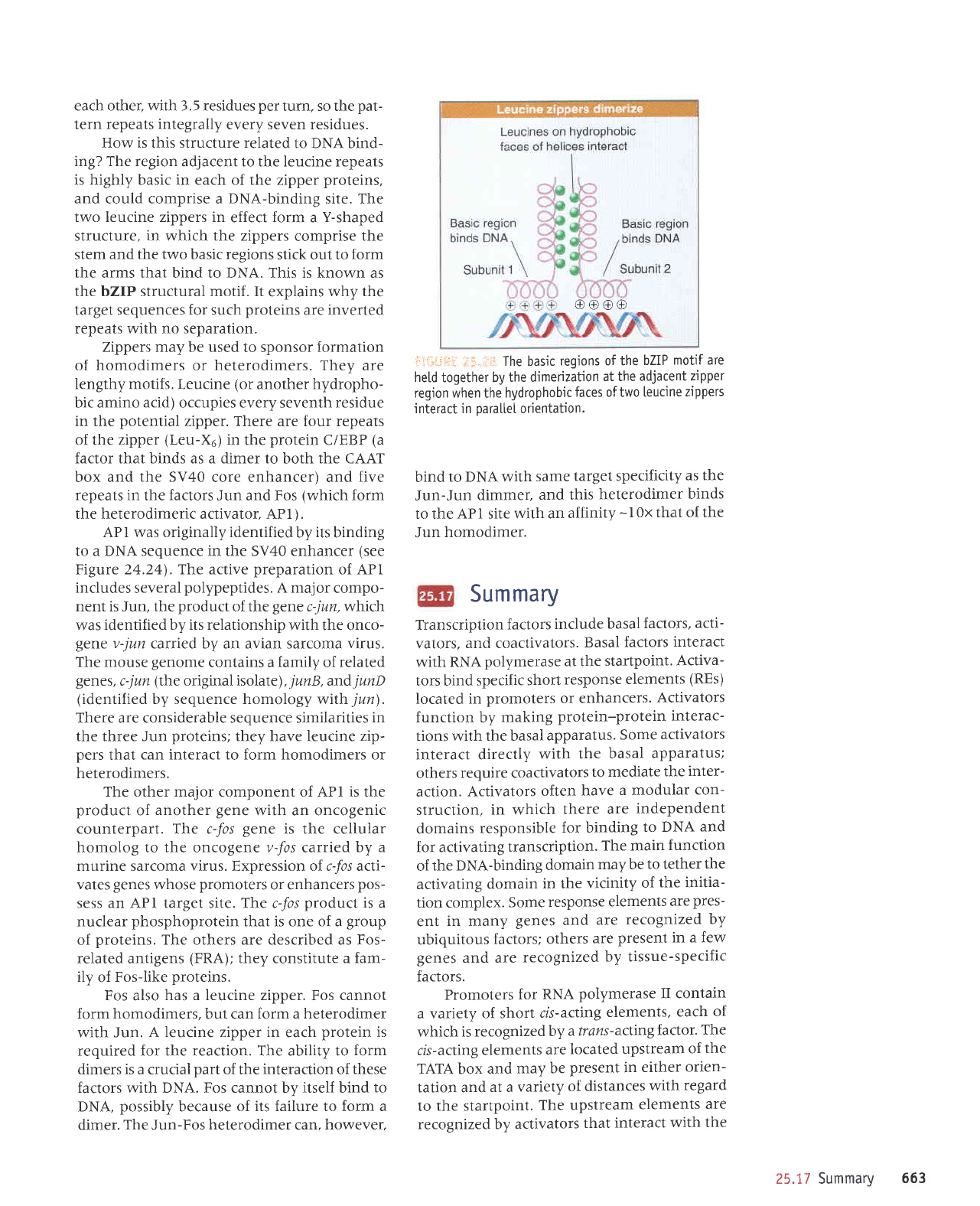
each other, with 3.5 residues
per
turn, so the
pat-
tern
repeats integrally
every seven residues.
How is this structure related
to DNA bind-
ing? The region
adjacent to the leucine repeats
is highly basic in each of the zipper
proteins,
and could comprise a DNA-binding site. The
two leucine zippers in
effect
form
a
Y-shaped
structure, in which the zippers
comprise
the
stem and the two basic regions
stick out to
form
the arms that bind to DNA. This is known as
the bZIP structural motif. It
explains
why the
target sequences
for
such
proteins
are inverted
repeats with no separation.
Zippers may be used
to sponsor
formation
of
homodimers
or
heterodimers.
They are
lengthy motifs. Leucine
(or
another hydropho-
bic amino
acid)
occupies every seventh residue
in the
potential
zipper. There are four repeats
of the zipper
(Leu-X6)
in the
protein
C/EBP
(a
factor that binds as a dimer to
both
the CAAT
box and
the SV40
core enhancer) and
five
repeats in
the
factors
Jun and Fos
(which
form
the heterodimeric activator, APt
).
API
was
originally identified
by
its
binding
to a DNA sequence in the SV40 enhancer
(see
Figure 24.24it . The active
preparation
of API
includes
several
polypeptides.
A major
compo-
nent is Jun, the
product
of the
gene
c-jun,which
was
identified by its relationship
with the onco-
gene v-jun
carried by an avian sarcoma
virus.
The mouse
genome
contains a family of
related
genes,
c-jun
(the
original isolate),
junB,
and
junD
(identified
by sequence homology with
jun).
There are considerable sequence similarities
in
the three Jun
proteins;
they have leucine
zip-
pers
that
can interact to form homodimers or
heterodimers.
The other major component of API is the
product
of
another
gene
with an oncogenic
counterpart. The c-fos
gene
is the cellular
homolog to the oncogene
v-los
carried
by a
murine sarcoma virus. Expression of c-fos acri-
vates
genes
whose
promoters
or enhancers
pos-
sess an API target site. The c-los
product
is
a
nuclear
phosphoprotein
that is one of a
group
of
proteins.
The others are described as Fos-
related antigens
(FRA);
they
constitute
a fam-
ily
of
Fos-like
proteins.
Fos also
has a leucine zipper. Fos cannot
form homodimers, but can
form a heterodimer
with Jun.
A leucine zipper in
each
protein
is
required for the reaction. The ability to
form
dimers is a crucial
part
of the
interaction
of
these
factors with DNA. Fos cannot by itself bind
to
DNA,
possibly
because
of its failure to form a
dimer. The Jun-Fos
heterodimer
can,
however,
irlt.;iiliii: :::'r.;l:iri
The basic
regions of the
bZIP
motif are
held
together
by the dimerization
at the adjacent
zipper
region when
the
hydrophobic
faces of two leucine
zippers
'interact
in
oara[[eI
orientation.
bind
to DNA with
same
target specificity
as the
Jun-Jun
dimmer,
and this
heterodimer
binds
to the API site
with an
affinity
-10x
that of the
Jun
homodimer.
Summary
Transcription
factors
include
basal
factors,
acti-
vators,
and coactivators.
Basal
factors
interact
with RNA
polymerase at the
startpoint.
Activa-
tors bind
specific short
response
elements
(REs)
located
in
promoters or enhancers.
Activators
function by
making
protein-protein
interac-
tions
with the basal
apparatus.
Some
activators
interact directly
with the
basal
apparatus;
others
require coactivators
to
mediate
the
inter-
action.
Activators
often
have
a modular
con-
struction,
in which
there
are
independent
domains
responsible
for binding
to DNA
and
for activating
transcription.
The main
function
of the
DNA-binding
domain
may be
to tether
the
activating
domain
in the
vicinity
of
the initia-
tion complex.
Some
response
elements
are
pres-
ent
in many
genes and
are
recognized
by
ubiquitous
factors; others
are
present in a few
genes
and are
recognized
by tissue-specific
factors.
Promoters
for
RNA
polymerase II contain
a variety
of short
czs-acting
elements,
each
of
which
is recognized
by
a trans-acting
factor.
The
crs-acting elements
are
located
upstream
of
the
TATA box
and
may be
present
in
either
orien-
tation and
at a variety
of distances
with
regard
to
the startpoint.
The upstream
elements
are
recognized by
activators
that
interact
with the
@@@@
25.17 Summary
663
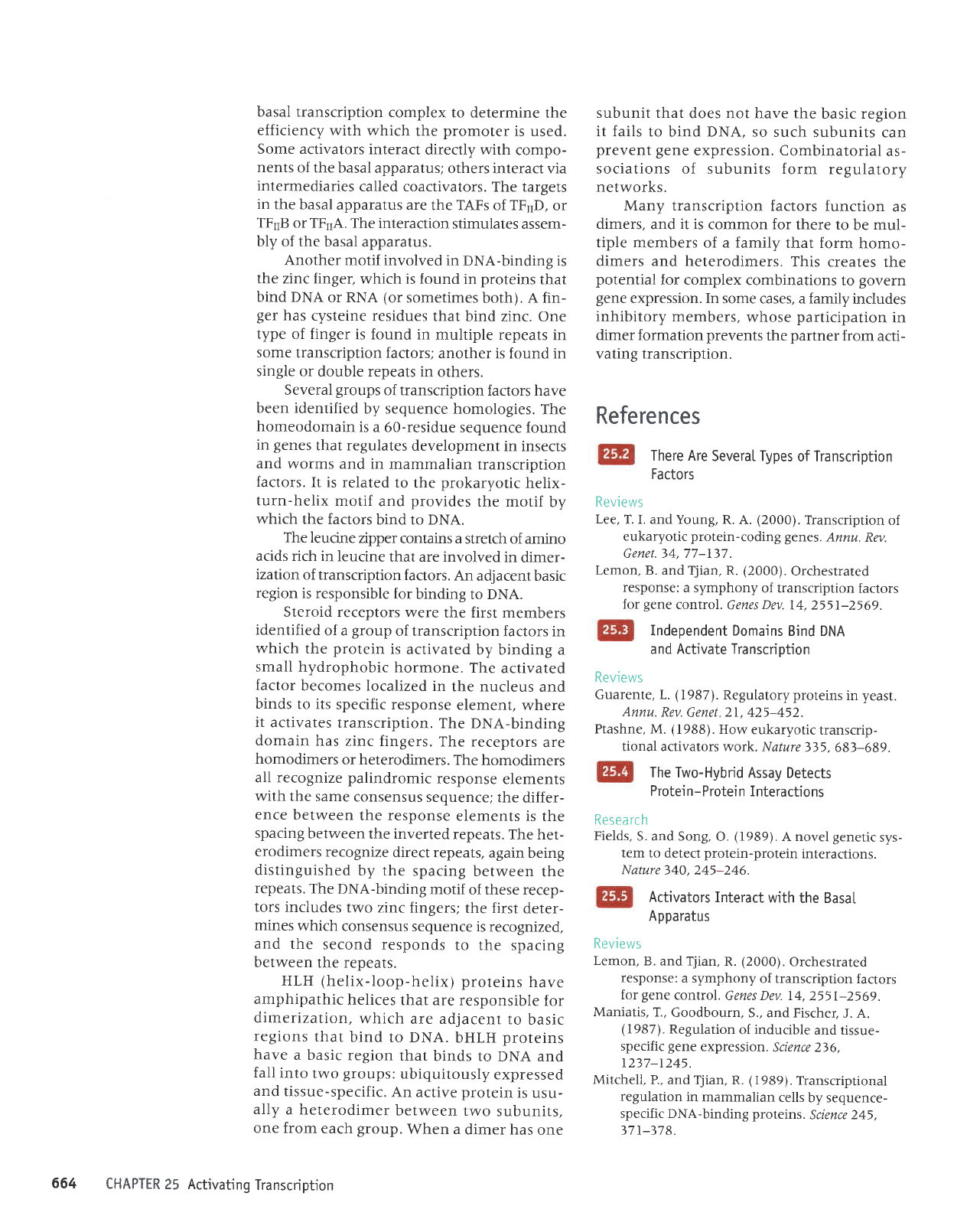
basal transcription
complex
to determine
the
efficiency with
which
the
promoter
is used.
Some activators
interact
directly with
compo-
nents
of the basal
apparatus;
others interact via
intermediaries
called coactivators.
The targets
in
the basal
apparatus are
the TAFs of TF11D,
or
TFnB
or TFnA.
The interaction
stimulates
assem-
bly
of the basal
apparatus.
Another
motif involved
in DNA-binding is
the zinc
finger, which is
found in
proteins
that
bind DNA
or RNA
(or
sometimes
both). A fin-
ger
has
cysteine
residues
that bind zinc.
One
type of finger
is found in
multiple repears
in
some
transcription
factors;
another is found in
single or
double repeats
in others.
Several
groups
of transcription
factors have
been
identified
by sequence
homologies.
The
homeodomain
is a 60-residue
sequence
found
in
genes
that regulates
development
in insects
and
worms and
in mammalian
transcription
factors.
It is
related to
the
prokaryotic
helix-
turn-helix
motif
and
provides
the motif
by
which
the factors
bind to lNA.
The leucine
zipper
contains a
stretch of amino
acids rich in
leucine
that are involved
in
dimer-
ization
of transcription
factors.
An
adjacent basic
region
is
responsible
for binding
to DNA.
Steroid receptors were
the first members
identified
of a
group
of transcription
factors in
which
the
protein
is
activated
by binding a
small
hydrophobic
hormone.
The
activated
factor
becomes localized
in
the nucleus
and
binds
to its
specific response
element,
where
it
activates
transcription.
The DNA-binding
domain
has
zinc fingers.
The receptors
are
homodimers
or heterodimers.
The
homodimers
all recognize palindromic
response
elements
with
the same
consensus
sequence;
the
differ-
ence between
the response
elements
is the
spacing
between
the inverted
repeats.
The het-
erodimers
recognize
direct
repeats,
again being
distinguished
by the
spacing
berween
the
repeats.
The DNA-binding
motif
of these recep-
tors
includes
two zinc
fingers;
the first
deter-
mines
which
consensus
sequence is
recognized,
and the
second
responds
to
the spacing
between
the repeats.
HLH
(helix-loop-helix)
proreins
have
amphipathic
helices
that are
responsible
for
dimerization,
which
are adjacent
to
basic
regions
that
bind
to DNA.
bHLH
proteins
have
a basic
region
that
binds to
DNA and
fall
into
two
groups:
ubiquitously
expressed
and
tissue-specific.
An active
protein
is usu-
ally
a heterodimer
between
two
subunits,
one from
each
group.
When a
dimer has
one
CHAPTER
25 Activating
Transcription
subunit that
does not have the
basic region
it fails
to bind DNA, so
such subunits
can
prevent
gene
expression. Combinatorial
as-
sociations of subunits f
orm regulatory
networks.
Many transcription
factors
function
as
dimers,
and
it
is common for
there to
be mul-
tiple members of a family
that form
homo-
dimers and heterodimers.
This
creates
tne
potential
for complex
combinations
to
govern
gene
expression. In
some cases, a family
includes
inhibitory members,
whose
participation
in
dimer formation
prevents
the
partner
from
acti-
vating transcription.
A?
Kererences
There Are
Several Types
of Transcription
Factors
Reviews
Lee,
T. I. and Young,
R. A.
(2000).
Ttanscriprion
of
eukaryotic
protein-coding
genes.
Annu. Rev.
GeneL )4,77-137.
Lemon,
B. and Tjian, R.
(2000).
Orchestrated
response:
a symphony
of transcription
factors
for
gene
control.
Genes
Dey.14,2551-2569.
Independent Domains
Bind DNA
and Activate Transcription
Guarente,
L.
(19871.
Regulatory proteins
in
yeast.
Annu.
Rev.
Genet
21,425-452.
Ptashne, M.
(
I 988). How
eukaryotic
transcrip-
tional activators
work. Nature
)35, 681-689.
The Two-Hybrid
Assay Detects
Protei n-
Protei n Interactions
Fields,
S. and Song,
O.
(1989).
A novel genetic
sys-
tem to
detect
protein-protein
interactions.
Nature
340,245-246.
Activators
Interact
with
the Basal
Apparatus
Reviews
Lemon,
B. and
Tjian, R.
(2000).
Orchestrated
response:
a symphony
of transcription
factors
for
gene
control.
Genes Dev. 14,2551-2569.
Maniatis,
T.,
Goodbourn,
S., and Fischer,
J. A.
(1987ll.
Regulation
of
inducible
and tissue-
specific
gene
expression.
Science 2j6,
t237-1245.
Mitchell,
P.,
and TJian, R.
(19S9).
Ttanscriprional
regulation
in
mammalian
cells
by sequence-
specific DNA-binding proteins.
Science 245,
371-j78.
Resea rch
Reviews
664
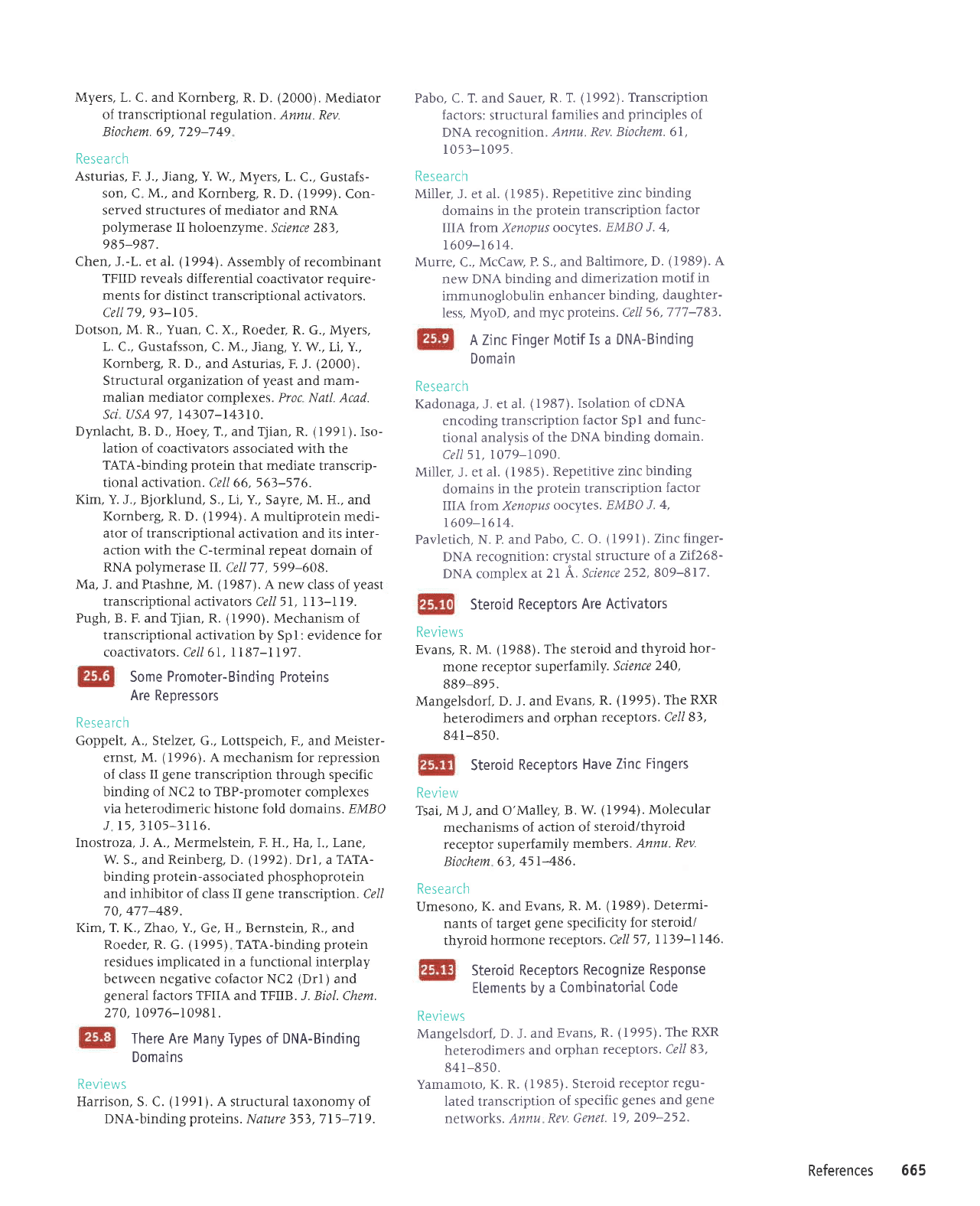
Myers, L. C. and I(ornberg,
R. D.
(2000).
Mediator
of transcriptional regulation
. Annu. Rev.
Biochem. 69
,
7 29-7 49
Resea
rch
Asturias, F.
J., Jiang,
Y.
W., Myers, L.
C., Gustafs-
son, C
M.,
and I(ornberg, R. D.
(1999).
Con-
served structures of me diator
and RNA
polymerase
II holoenzyme.
Science 283,
985-987.
Chen, J.-L. et al.
(1994).
Assembly
of recombinant
TFIID reveals
differential coactivator require-
ments for distinct transcriotional
activators.
Cell79,93-105.
Dotson, M. R., Yuan,
C.
X.,
Roeder, R. G., Myers,
L.
C.,
Gustafsson,
C. M., Jiang, Y. W., Li, Y.,
I(ornberg, R. D.,
and Asturias, F.
J.
(2000).
Structural organization of
yeast
and
mam-
malian mediator
complexes. Proc
Natl.
Acad.
Sci USA
97, 14307
-l43l0.
Dynlacht, B. D., Hoey, T., and Tjian, R.
(I991).
Iso-
lation of coactivators
associated with the
TATA-binding
protein
that mediate
transcrip-
tional activation. Cell
66, 563-576.
I(m, Y. J., Bjorklund,
S.,
Li, Y.,
Sayre, M. H., and
I(ornberg, R. D.
(1994).
Amultiproteinmedi-
ator of transcriptional
activation and its inter-
action with the
C-terminal repeat domain of
RNA
polymerase
Il. Cell 77, 599-608.
Ma, J. and Ptashne, M.
(
I 987
)
. A new
class of
yeast
transcriptional activators
Cell 51, I I 3-I 19.
Pugh, B. F. and Tjian, R.
(I990).
Mechanism of
transcriptional activation
by Sp I : evidence
for
coactivators. Cell 61, I
187-l
I97.
Some
Promoter-Binding
Proteins
Are
Reoressors
Resea rc h
Goppelt, A., Stelzer, G., Lottspeich, F.,
and
Meister-
ernst,
M.
(1996).
A mechanism
for repression
of class
II
gene
transcription through specific
binding of NC2 to TBP-promoter
complexes
via heterodimeric histone fold
domains.
EMBO
J 15,3t05-)tt6.
Inostroza, J. A., Mermelstein, F. H., Ha, I.,Lane,
W.
S.,
and Reinberg, D.
(1992).
Drl, a
TATA-
binding
protein-associated phosphoprotein
and inhibitor of class II
gene
transcription. Cel/
70,477-489.
I(im, T. K., Zhao, Y.,
Ge,
H
,
Bernstein, R., and
Roeder, R.
G.
(1995)
TATA-bindingprotein
residues implicated in
a
functional
interplay
between
negative
cofactor NC2
(Drl
)
and
general
factors TFIIA
and TFIIB. J. Biol. Chem.
270, t0976-t098r.
There Are Many Types
of
DNA-Binding
Domains
Harrison, S. C.
(1991).
A structural taxonomy of
DNA-binding
proteins.
Nature 35),
7 l5-7 19.
Pabo, C. T. and Sauer,
R. T.
(1992).
Tlanscription
factors:
structural
families
and
principles
of
DNA recognition.
Annu.
Rev. Biochem. 61,
1053-1095.
Resea rch
Miller, J. et al.
(1985).
Repetitive
zinc binding
domains in the
protein
transcription
factor
IIIA from Xenopus oocytes.
EMBO J. 4,
t609-16t4.
Murre,
C.,
McCaw, P. S.,
and Baltimore,
D.
(1989).
A
new DNA binding
and
dimerization
motif in
immunoglobulin
enhancer
binding, daughter-
less, MyoD, and
myc
proteins.
Cell 56,
777
-7
83.
A Zinc Finger
Motif
Is
a
DNA-Binding
Domain
Resea rc h
I(adonaga, J. et al.
(1987).
Isolation
of cDNA
encoding transcription
factor Spl and
func-
tional analysis
of the
DNA
binding domain.
Cell 51, 1079-1090.
Miller,
J. et
al.
(1985).
Repetitive
zinc binding
domains
in the
protein
transcription
factor
ILIAfrom Xenopus
oocytes.
EMBO J.
4,
t609-t614.
Pavletich,
N.
P. and
Pabo, C. O.
(1991).
Zinc finger-
DNA
recognition: crystal
structure
oI a
Zif268'
DNA comolex
at 2I
A.
Science
252,809-81
7.
Steroid Receptors
Are Activators
Reviews
Evans,
R. M.
(
1988) .
The steroid
and thyroid
hor-
mone receptor
superfamily.
Science
240,
889-89 5.
Mangelsdorf,
D. J. and
Evans,
R.
(1995). The RXR
heterodimers
and orphan
receptors. Cell
83,
841-850.
Steroid
Receptors
Have
Zinc Fingers
Review
Tsai,
M
J, and
O'Malley,
B. W.
(1994r. Molecular
mechanisms of action
of
steroid/thyroid
receptor superfamily
members.
Annu.
Rev.
Biochem 6),451-486.
Resea
rch
Umesono,
I(.
and
Evans,
R.
M.
(1989).
Determi-
nants of target
gene
specificity
for steroid/
thyroid
hormone
receptors.
Cell 57,
1139-1146.
Steroid Receptors
Recognize
Response
Etements by
a Combinatorial
Code
Reviews
Mangelsdorf, D. J.
and Evans,
R.
\1995).
The RXR
heterodimers
and orphan
receptors.
Cell 83'
84 l
-85
0.
Yamamoto,
K. R.
(1985).
Steroid
receptor
regu-
Iated transcription
of specific
genes
and
gene
networks.
Annu
Rev. Genet.
19,209-252.
Reviews
References
665
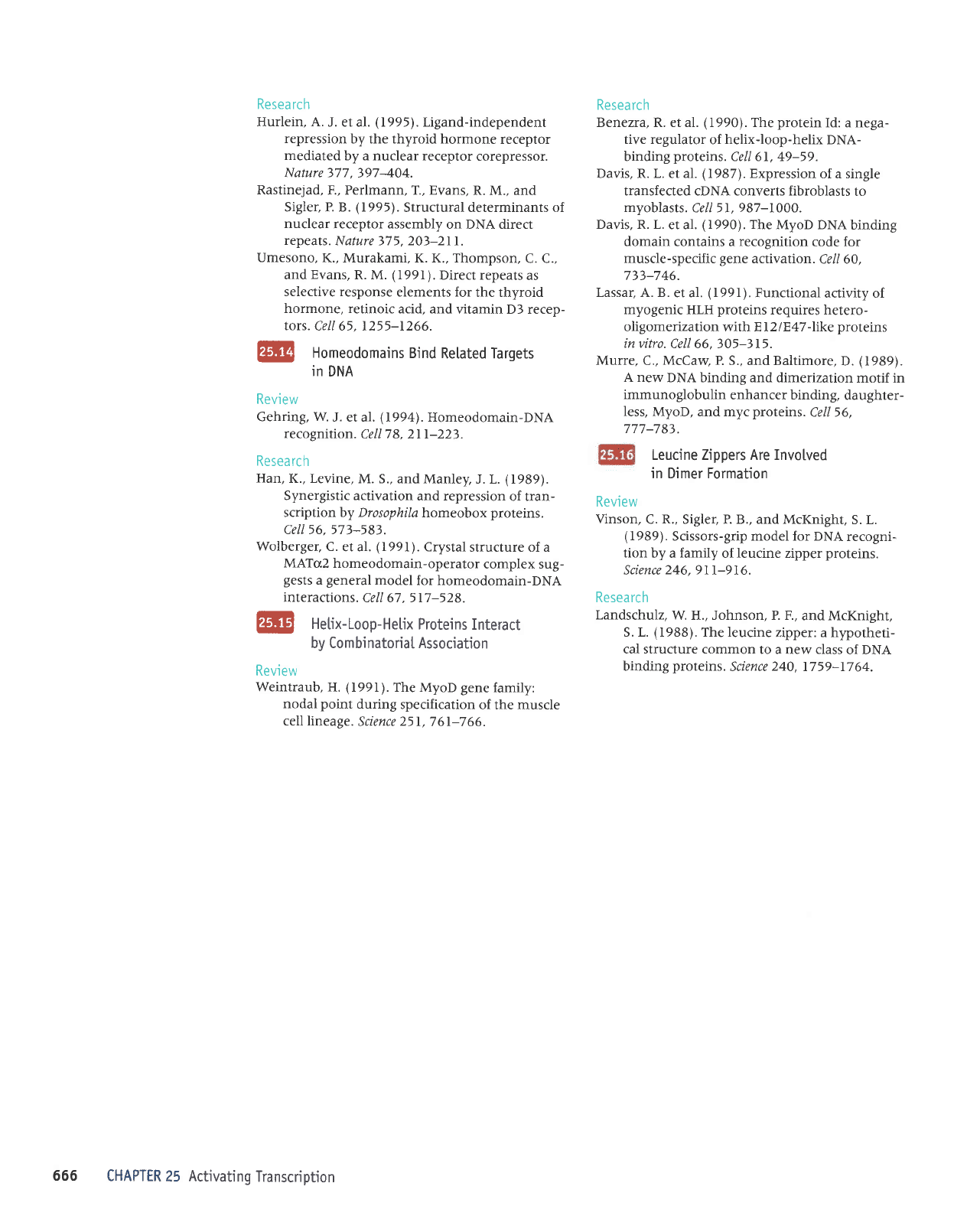
Resea rch
Hurlein, A.
J. et al.
(1995).
Ligand-independent
repression
by the thyroid hormone
receptor
mediated
by a nuclear receptor
corepressor.
Nature )77,
i97404.
Rastinejad,
F., Perlmann, T., Evans,
R. M., and
Sigler, P. B.
(1995).
Structural determinants of
nuclear
receptor assembly
on DNA direct
repeats.
Nature )7 5, 20)-21 l.
Umesono,
K., Murakami, K. K., Thompson,
C. C.,
and
Evans,
R. M.
(
l99l
)
. Direct repeats
as
selective response
elements for
the thyroid
hormone, retinoic
acid, and
vitamin D3 recep-
tors.
Cell 65, 1255-1266.
@
Homeodomains
Bind
Related Targets
in
DNA
Review
Gehring,
W.
J. et al.
(1994).
Homeodomain-DNA
recognition.
Cell
7
8, 2l l-223.
Resea rch
Han,
I(., Levine,
M. S., and Manley,
J. L.
(1989).
Synergistic activation
and repression
of tran-
scription by Drosophila
homeobox
proteins.
Cell 56, 571-58).
Wolberger,
C.
et al.
(199I).
Crystal
structure of a
MATc,2
homeodomain-operator
complex sug-
gests
a
general
model
for homeodomain-DNA
interactions.
Cell 67, 517-528.
Hetix-Loop-Helix
Proteins
Interact
by CombinatoriaI Association
Weintraub,
H.
(
l99l
).
The MyoD
gene
family:
nodal
point
during
specification
of the muscle
cell lineage.
Science
251,
7 6l-7
66.
Research
Benezra, R. et al.
(1990).
The
protein
Id: a nega-
tive regulator
of
helix-loop-helix
DNA-
binding
proteins.
Cell 61,49-59.
Davis, R. L. et al.
(1987
|
. Expression
of a single
transfected cDNA converts fibroblasts
to
myoblasts.
Cell 5L,
987-1000.
Davis, R. L.
et al.
(I990).
The
MyoD DNA
binding
domain contains a recognition code for
muscle-specific
gene
activation.
Cell 60,
7JJ-746.
Lassar, A. B.
et al.
(1991).
Functional
activity of
myogenic HLH
proteins
requires hetero-
oligomerization with El2 /E47
-like
proteins
in vitro.
Cell 66, 305-315.
Murre,
C.,
McCaw
P. S., and Baltimore,
D.
(1989).
A new
DNA binding and dimerization
motif in
immunoglobulin
enhancer binding,
daughter-
less,
MyoD, and myc
proteins.
Cell 56,
777-783.
Leucine Zippers Are Involved
in Dimer Formation
Review
Vinson,
C.
R.,
Siglea P. B., and McKnight,
S. L.
(1989).
Scissors-grip model for DNA
recogni-
tion
by a
family
of leucine zipper
proteins.
Science
246, 9lI-916.
Research
Landschulz,
W. H., Johnson, P. F.,
and McKnight,
S. L.
(1988).
The leucine
zipper: a hypotheti-
cal structure common
to a new class
of DNA
binding
proteins.
Science
240,
1759-1764.
@
Review
666
CHAPTER
25
Activating
Transcription
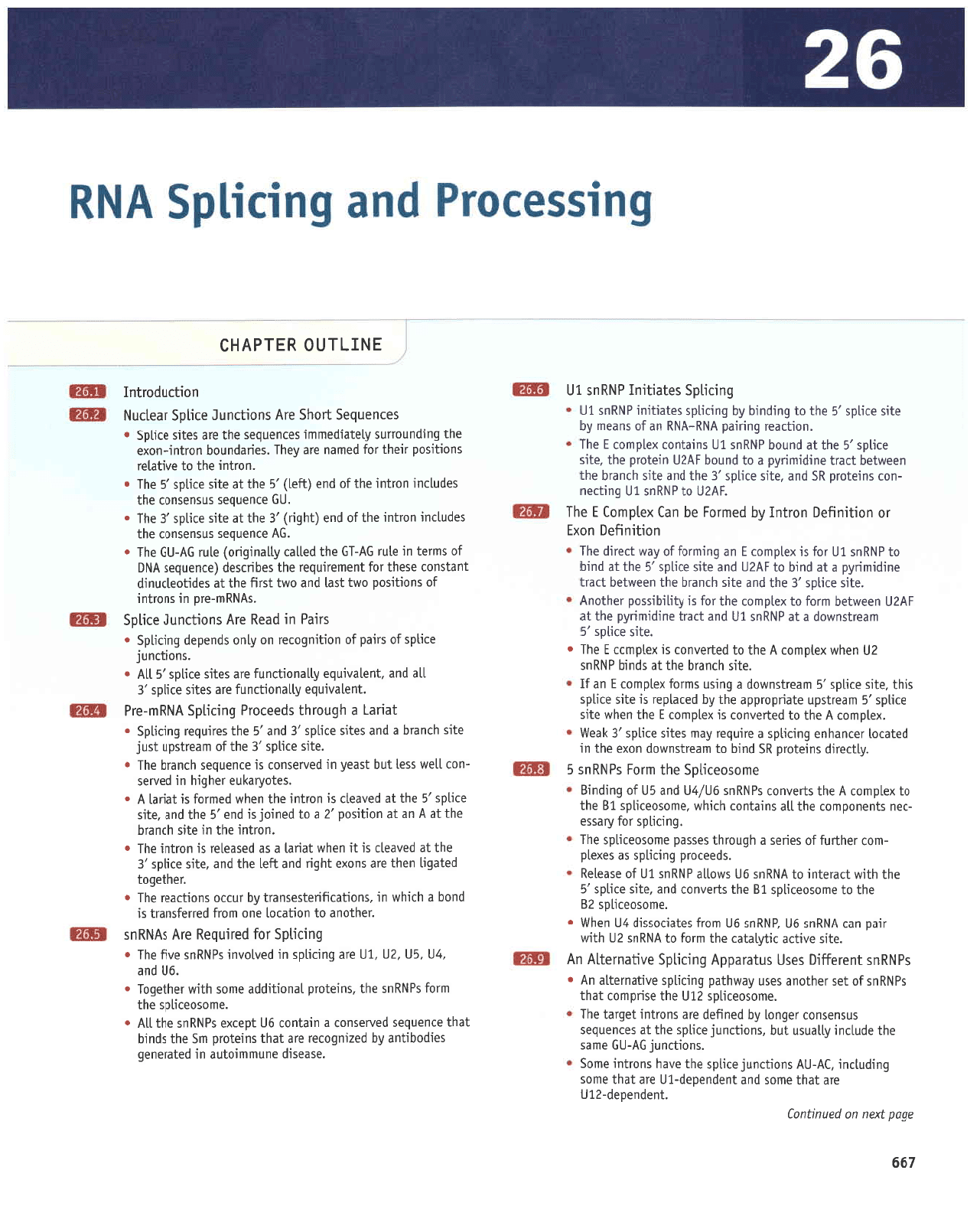
199
aDDd
lrau
uo
panulluoJ
.luepuedep-71
6
ele
lPql
auos
pup
luapuaoap-In
ale
leql
auos
6urpnlruL
'lV-nV
suorllunI erLlds
aq] anpq
-suollur
auos
'suorpunr
9v-ng
aluPs
aql epnlrur Allensn
1nq
'suoLlrunI
arrlds aq1
1e
seruenbas
snsuesuol
ta6uol [q
peulJep
olp suollur
1e6re1
aq1
'auosoarrtds
ZIn
aql asuduor
1eq1
sdNUus
Jo
les
reqloue
sasn AeMqlpd
6uLrrlds aArlpula]lp u!
r
sdNUus
tueraJJL6
sasn snlelpddV
6uortdS a^qeulellv
uV
'a1s
a^tllp rr{1e1er
aql uloJ
ol
VNUUs
Zn
ql$
lrPo uPl
vNUus 9n
'dNUus
gn
uolj
salpDosstp
tn
ueq|
.
'auosoalrlos
zg
eql 0l euosoelrlds
IE
aql sile^uol
pup
'olrs
alrlds
,9
aql
qllM
llPrelul
0l
vNUus
9n
sMollp
dNUus
ln
Jo
espalau
'spaaro.rd
6urrrlds se
saxald
-urol
raqilnj
Jo
souas e
qEnorql
sassed auosoerLlds
aq1
'6upLlds
.ro1 f-resse
-rau
sluauoduol eql
llp
surpluol tllrr.lM
'oruosoarLlds
1g
eq1
o1 xalduor
V
aql
sile^uot s61r1Xus
91-1/7i1
pup
En
Jo
6urpurg
aLuosoarqd5
aql uro1 sdNUus
g
'r{1pat1p
suralo.rd
US
pulq
o} upet}suMop
uoxo aq} ur
palerol
rarupquo bunrlds e
arLnbar
feu
salrs a:qds,g
1ea41
'xalduor
V
aql ol
paila^uot
sr xelduror
I
oql uaqm olrs
arrtds
,9
uearlsdn eleudordde
aq1
fq
pareldar
sr
alrs arqds
srql'alrs alrlds,g urparlsuMop
e 6uLsn su.rol xelduor
3
ue;1
'elrs
qluetq
aql
lP
spurq
dNUus
Zn
uaqM
xalduor
V
aql ol
paila^uol
sr xalduor
I
aHI
o
'elrs
alrlos
,g
uparlsumop
p
lp
dNUus
[n
pup
]lpll
aurpLruuAd
aq1
1e
lvzn
uaa/'^laq uroJ ol
xalduor
aql loJ sr filqLqrssod leqlouv
'olrs
olrtos
,€
aql
puP
a}s
qlupiq
aql uoaMlaq
pp.ll
eurprruuAd
p
lp
purq
01
JVZn
pue
elrs
olttds
,g
oql
tp
purq
ol
dNUus
ln
ro1
s!
xalduor
I
ue bururol
1o
fiervr
lrerrp
eqg
u0rlluLlao uoxl
ro uorlrulJag uorlul Aq
pauuol
aq upl
xalduro3
3
eq1
'lVZn
ol
dNUus
In
6urlrau
-uor
suralord
US
pup
'alrs
arLlds,E aql
pue
elrs
qluetq
aql
ueeMlaq
1rel1
aurpruuAd
e o1
punoq
1y71'1
uralord aql
'al!s
arrlds,g aql
lp
punoq
dNUUs
In
suleluol xalduor
3
aq1
'uorllpel
buured
y1X-yNU
up
Jo
sueaur r\q
alls atrtds,E aql ol 6utpurq r\q 6urrrtds
salprlrur
dNUus
In
6urltds
salPqrul
dNUus
In
s a r
p
o
q
rr
u
p,tq
p,',
u o o'i# :;:ttill
i'Tjilif .l
i
li,T'1[:
;
1eq1
aruanbas
peruesuol
p
ulpluol
911
ldarxa
sl[[us a!]
ll!
r
'ourosoalrl0s
aql
rlloJ sdNUus
aql'su1e1ord
lPuorlrppe
auos
qltM
taq1a6o1
o
9n
puP
'rn'gn'zn':'||
ale 6uDuds
ur
pa^lo^ut
s/[rl!us oA4 a{]
o
6urrrlds roJ
parrnbau
arv sVNUus
.laqlouP
0l uotlPlol
ouo lllolj
pallo}suPll
st
puoq
p
qlrqM
ut'suoqelguelsasupll
rtq
tnrro
suotllPat aqf
.
'raqla6ol
pele6q
ueql o.lp
suoxa
lqbu
pue
Uel
eql
puP
'alts
alnds,E
eql
}P
pa^Pelr
st
lt
uoqM
leuPl
e sP
pasPalal
st
uollut aqf
.
'u0r1ur
aql ur alrs
qluPlq
aqt
le
V
ue
1e
uorlrsod
,7
e o1
peutol
s!
pua
,g
aql
pue
'a]ts
elrlcls
,9
eql
lp
pa^Poll
sr uollut aql uaqM
poulloJ
st
|PUel
!
r
'salortelna
raqbrq
uL
parues
-uol
llem
ssal
lnq lseef
ut
paruasuol
st aluanbas
qruelq
aql
.
elrs arrlds
,€
eql
Jo
urpallsdn
lsn[
olrs
qluplq
p
pue
selrs
arqds
,g
pue
,g
eql sallnbal
6uLrqd5
r
lPllel
e
q6norql
spaalold 6unt1d5
vNUl.u-ard
'lualenLnba
{11euoL1run;
aie solls arttds
,€
lle
pup
'tualp^Lnbe
r\lleuoqrunJ olP
salts alttds
,9
llV
.
'suotpunI
erqds
1o
srted;o uoqLuboral
uo r{1uo spuedap
6utrtld5
o
sltPd ul
peau
alv suotpunl
e]tlds
'svNUu-alo
ul suo.llul
jo
suorlr.socl
oM]
lsPl
pue
oMl
]slg
oql
le
sopqoallnutp
luPlsuol
osaql
roJ
luaual!nba.l
aql
sequlsap
(aruenbas
y16
Jo
suuol
ur alnr
gv-lg
aql
paller
r{11eur6uo) alil
gv-n9
aq1
.
'gv
aluanDes
snsuasu0r
aql
sopnllur uollul
aql
1o
pua (1q6u)
,€
eql
lP
alrs altlds
,€
egl
.
'ng
aluanbes
snsuasuol aql
sepnllur
uollur
eql
Jo
pua (ge1)
,9
aql
le
ells altlds
,9
aul
r
'uollul
aql
ol a^tlPlar
suollrsod
raql roj
peuPU
aie [eqI
'sauepunoq
uollut-uoxa
eql 6urpunollns
AlalerpauruL saluanbes
aql ale salls
altlds
.
soluenbas
iloqs
alv
suotpunI
a]tlds lPallnN
uo!pnpollul
3NI]INO
U]IdVH3
o
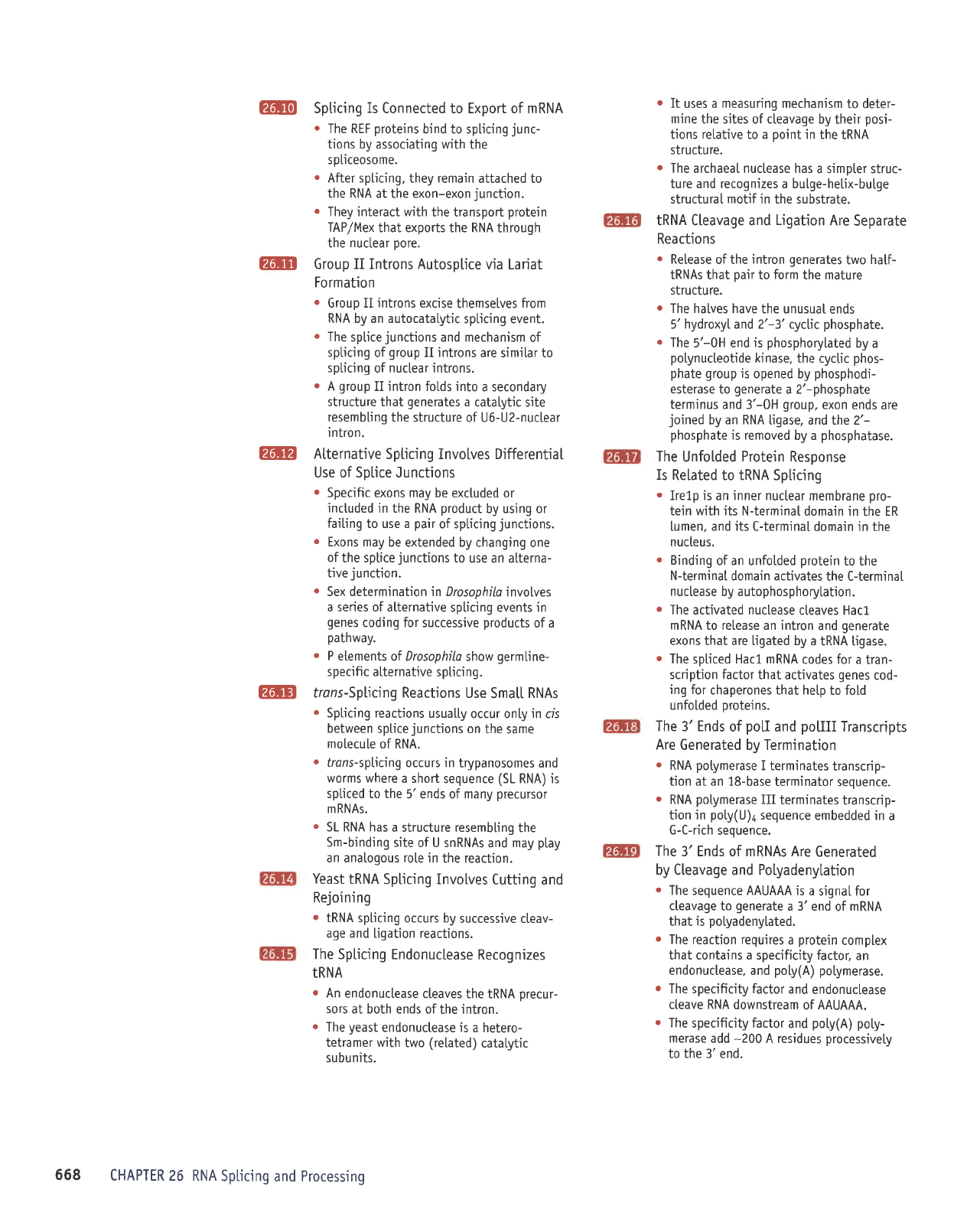
?EM
?frd
?r13ar
Spticing
Is
Connected to Export of mRNA
.
The REF
proteins
bind to splicing
junc-
tions
by associating with the
spliceosome.
.
After spLicing,
they
remain
attached to
the RNA at the exon-exon
junction.
.
They interact with
the transport
protein
TAP/Mex
that exports the RNA
through
the
nuctear
oore.
Group Ii Introns Autosptice
via Larjat
Formation
.
GrouD II introns excise
themselves
from
RNA by an autocatalytic
spticing event.
.
The
splice
junctions
and mechanism
of
spticing of
group
II introns
are similar to
spticing
of
nuctear
introns.
r
A
group
II intron folds into
a secondary
structure that
generates
a
catalytic site
resemb[ing
the structure
of U6-U2-nuctear
intron.
Atternative
Spticing Invotves DifferentiaI
Use of Sptice Junctions
.
Specific
exons
may
be exctuded or
inctuded
jn
the RNA
product
by using or
faiting
to use a
pair
of spticing
junctions.
o
Exons may
be extended by changing
one
of
the sptice
junctions
to
use an alterna-
tive
junction.
o
Sex determination in Drosophila
involves
a series of atternative
sp[ic'ing events in
genes
coding for successive
products
of a
pathway.
.
P
etements of Drosophila
show
germ[ine-
specifi c atternative spticing.
frans-Splicing
Reactions Use
Smatl
RNAs
.
Spticing reactions
usuatly
occur onty
in
crs
between
splice
junctions
on
the same
molecule
of RNA.
e
trons-spticing
occurs in
trypanosomes and
worms where
a short
sequence
(SL
RNA) is
spliced to the
5'ends of many
precursor
mRNAs.
.
SL RNA has
a structure resemb[ing
the
Sm-binding
site of U snRNAs
and
may
ptay
an anatogous role in
the reaction.
Yeast
IRNA
Spticing Involves
Cutting and
Rejoining
o
IRNA
spl.icing occurs by
successive cteav-
age and Ligation reactions.
The
Spl.icing Endonuclease
Recognizes
tRNA
o
An
endonuclease
cteaves the IRNA
orecur-
sors
at both ends
of the intron.
e
The
yeast
endonuctease is
a hetero-
tetramer with
two
(retated)
catatytic
subunits.
.
It
uses a
measuring
mechanism
to deter-
mine
the sites of cleavage
by their
posi-
tions retative to a
point
in
the IRNA
structu
re.
.
The archaeal nuctease has
a simpter struc-
ture and recognizes a buLge-helix-bulge
structural motif in the substrate.
IRNA Cleavage and
Ligation
Are
Separate
Reactions
o
Release
of the
intron
generates
two
half-
tRNAs that
pair
to
form
the mature
structure.
o
The hatves
have the unusual
ends
5' hydroxyl and 2'-3' cyctic
phosphate.
r
The
5'-0H end
is
phosphorytated
by a
polynucleotide
kinase,
the cyctic
phos-
phate group
is
opened by
phosphodi-
esterase
to
generate
a 2'-phosphate
terminus
and 3'-0H
group,
exon ends
are
joined
by an RNA
ligase, and the 2'-
phosphate
is removed
by a
phosphatase.
The
Unfotded
Protein
Response
Is
Related to IRNA Spticing
.
Irelp is an inner nuclear
membrane
pro-
tein with its N-terminal
domain in the ER
lumen, and its C-terminal
domain in the
nucteus.
o
Binding
of an unfolded
protein
to the
N-terminal
domain activates
the C-terminaI
nuctease
by autophosphorytation.
o
The activated nuclease
cteaves Hac].
mRNA to release an intron
and
generate
exons that are ligated by
a IRNA tigase.
.
The spliced Hacl mRNA
codes for a
tran-
scription factor that
activates
genes
cod-
ing for
chaperones that hetp
to fotd
unfotded
proteins.
The 3' Ends
of
pof
and
polIII
Transcripts
Are
Generated by Termination
r
RNA
potymerase
I terminates
transcrip-
tion at an L8-base
terminator
seouence.
o
RNA
poLymerase
III
terminates
transcrip-
tion in
poty(U)a
seQU€nce
embedded in
a
G-C-rich
seouence.
The
3' Ends of mRNAs Are
Generated
by
Cteavage and
Potyadenytation
r
The sequence AAUAAA
is a
signaI for
cleavage to
generate
a 3'end
of mRNA
that
is
pol.yadenylated.
.
The reaction
requires
a
protein
complex
that contains a specificity factor,
an
endonuclease, and
poty(A)
polymerase.
r
The specificity factor
and
endonuctease
cteave RNA
downstream
of
AAUAAA.
.
The
specificity factor
and
poty(A)
poty-
merase
add
-200
A residues
processivety
to the 3'end.
?frtill
668
CHAPTER 26 RNA
Spticing
and Processing
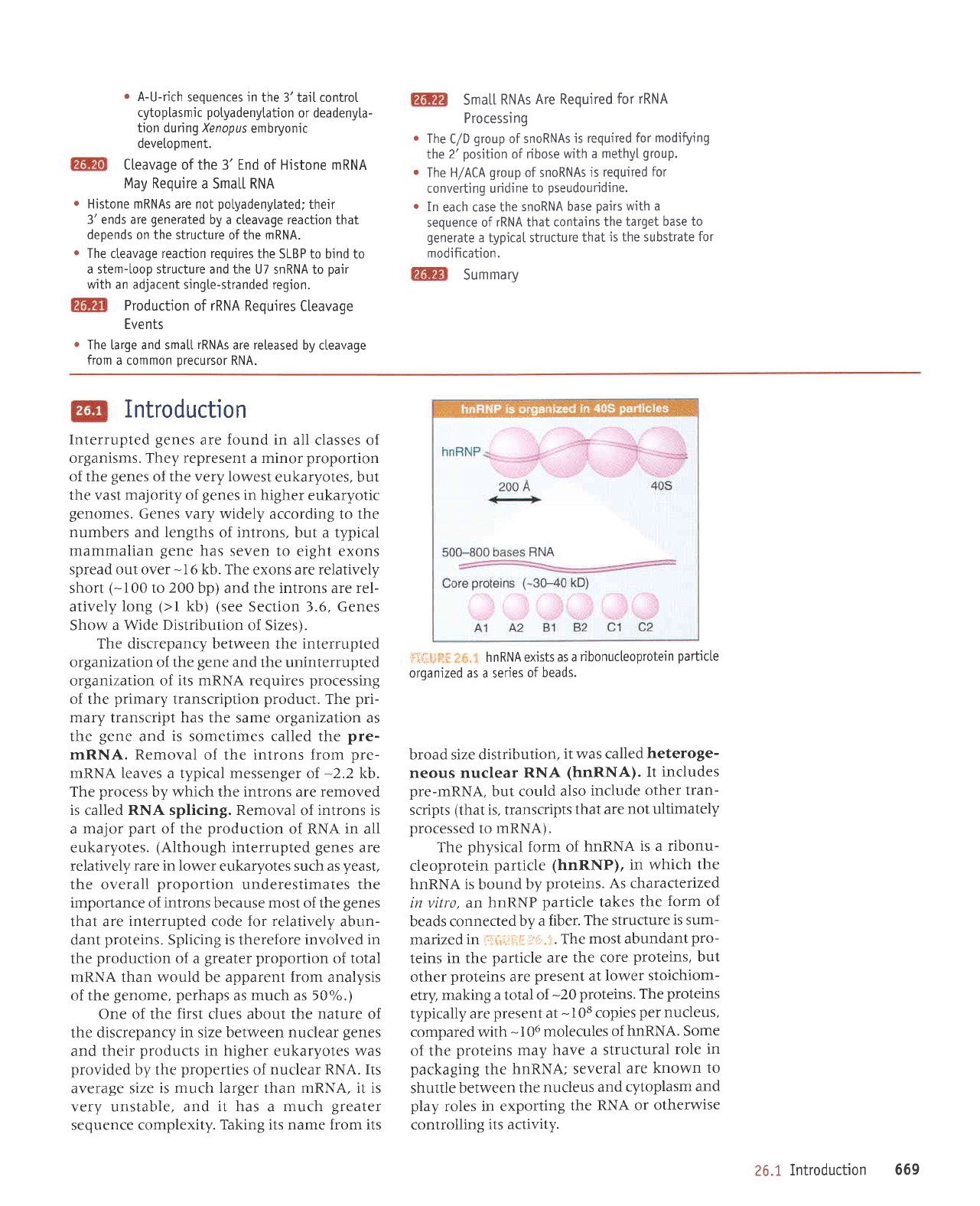
o
A-U-rich
sequences in
the 3'taiI control
cytoplasmic
potyadenytation
or deadeny[a-
tion during Xenopus
embryonic
deve[ooment.
Cteavage ofthe 3'End
of
Histone mRNA
May Require
a Smatl RNA
.
Histone mRNAs are not
poLyadenylated;
their
3'ends are
generated
by a cteavage reaction that
depends on the structure
of the
mRNA.
.
The
cteavage
reaction requires
the
SLBP to bind to
a stem-Loop structure and the
U7 snRNA to
pair
with an adjacent singte-stranded region.
Production
of rRNA
Requires Cleavage
Events
o
The [arge and smat[
rRNAs
are released
by cteavage
from
a common orecursor RNA.
Smatt
RNAs
Are Required
for rRNA
Processi
ng
.
The
C/D
group
of snoRNAs
is required
for modifying
the
2'
position
of ribose
with a
methyl
group.
.
The H/ACA
group
of snoRNAs
is required
for
converting uridine
to
pseudouridine.
o
In
each case the
snoRNA
base
pairs
with a
sequence of
rRNA that contains
the target
base to
generate
a typicaI structure
that
is the substrate
for
modification.
Summarv
Introduction
Interrupted
genes
are found in
all classes of
organisms. They represent a minor
proportion
of the
genes
of the
very
lowest
eukaryotes, but
the vast
majority
of
genes
in higher eukaryotic
genomes.
Genes vary widely
according to the
numbers and lengths
of introns, but a typical
mammalian
gene
has seven
to eight exons
spread out over
-
I 6 kb. The
exons are relatively
short
(-100
to
200
bp) and the introns are rel-
atively long
(>l
kb)
(see
Section
3.6, Genes
Show a Wide
Distribution
of Sizes).
The discrepancy between
the
interrupted
organization of the
gene
and
the uninterrupted
organization
of its nRNA requires
processing
of the
primary
transcription
product.
The
pri-
mary transcript has the
same organization as
the
gene
and
is
sometimes called the
pre-
mRNA. Removal
of the
introns
from
pre-
mRNA leaves a typical messenger of
-2.2
kb.
The
process
by which the introns are removed
is called RNA splicing. Removal
of
introns is
a major
part
of the
production
of RNA in all
eukaryotes.
(Although
interrupted
genes
are
relatively rare
in lower
eukaryotes such as
yeast,
the overall
proportion
underestimates the
importance of introns because most of the
genes
that are
interrupted
code
for relatively
abun-
dant
proteins.
Splicing
is
therefore involved
in
the
production
of a
greater proportion
of total
nRNA than would be apparent
from
analysis
of the
genome, perhaps
as much as 50%.)
One of the first clues about the nature of
the discrepancy
in size between nuclear
genes
and their
products
in higher
eukaryotes was
provided
by the
properties
of nuclear
RNA. Its
average size
is much larger
than
nRNA, it is
very unstable, and
it has
a
much
greater
sequence complexity.
Taking its name from its
r
.,,
:
,
'
hnRNA exists
as a
ribonucteoprotein
particte
oroanized as a series
of beads.
broad size distribution.
it was called
heteroge-
neous nuclear
RNA
(hnRNA). It includes
pre-mRNA,
but could
also
include
other tran-
scripts
(that
is, transcripts
that
are not ultimately
processed
to
nRNA).
The
physical form of
hnRNA
is a ribonu-
cleoprotein
particle
(hnRNP), in which
the
hnRNA is bound
by
proteins. As characterized
in vitro, an hnRNP
particle takes
the
form of
beads connected
by a
fiber.
The structure
is sum-
marized
in
t
i'.
r,;lrr
,;{
i.
The
most abundant
pro-
teins
in the
particle
are
the core
proteins,
but
other
proteins
are
present
at
lower
stoichiom-
etry, making
a total of
-20
proteins. The
proteins
typically are
present
at
-
I 08
copies
per
nucleus,
compared with
-l
06 molecules
of hnRNA.
Some
of the
proteins may have
a structural
role in
packaging
the hnRNA;
several
are known
to
shuttle
between the
nucleus
and
cytoplasm
and
play
roles in exporting
the
RNA or otherwise
controlling
its activity.
26.1
Introduction
669
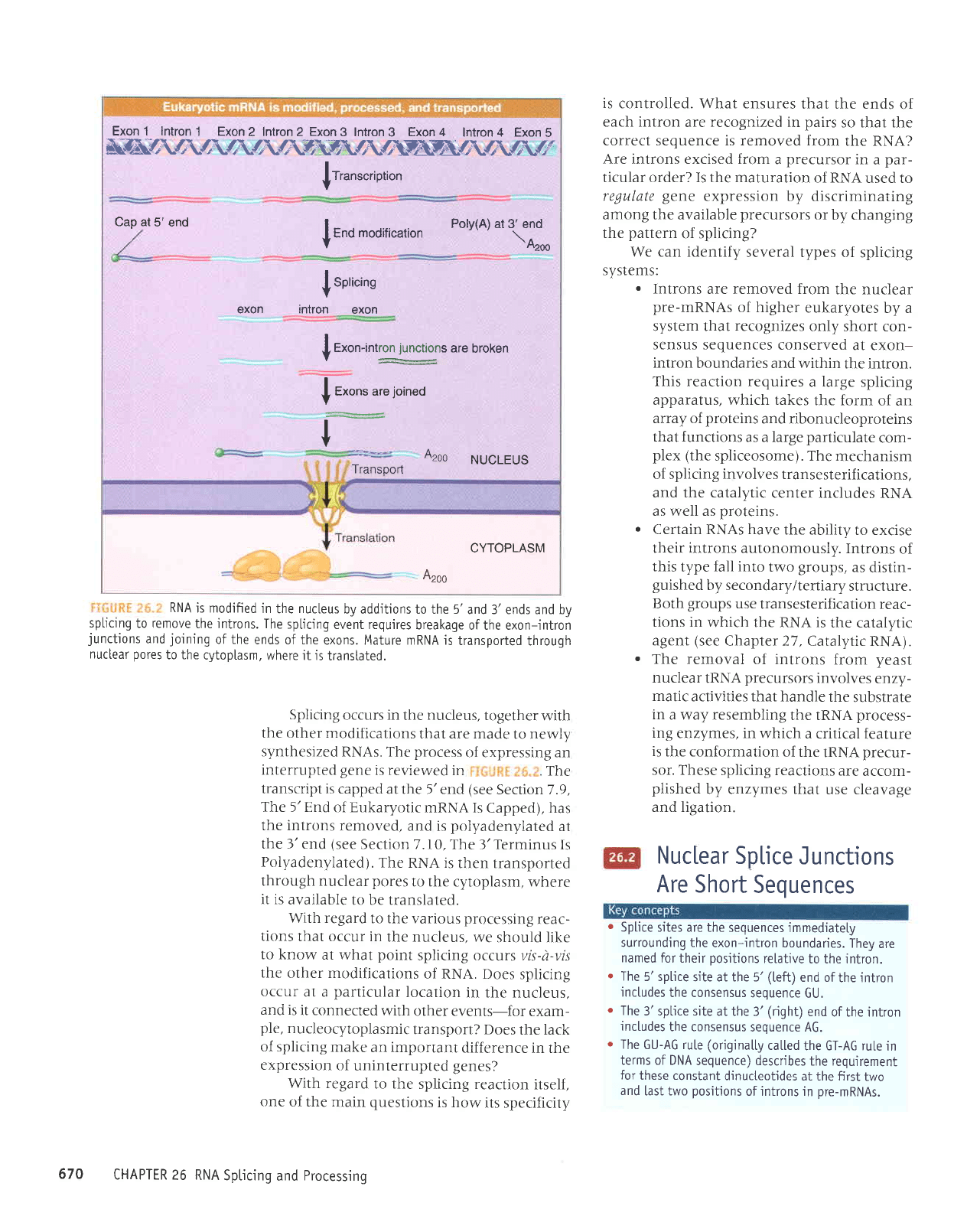
Cap at
5' end
Exon
1
lntron
1 Exon
2 Intron 2 Exon
3 Intron
3
Exon4
lntron4 Exon 5
I
f
Transcription
is
controlled. What ensures
that the ends
of
each intron
are
recognized
in
pairs
so that the
correct sequence is removed from
the RNA?
Are introns excised from
a
precursor
in
a
par-
ticular order? Is the maturation
of RNA
used to
regulate
gene
expression by discriminating
among the available
precursors
or by changing
the
pattern
of splicing?
We can identify
several types of
splicing
systems:
.
Introns
are removed from
the nuclear
pre-mRNAs
of higher
eukaryotes
by a
system that
recognizes
only shclrt con-
sensus sequences
conserved
at exon-
intron
boundaries and within
the intron.
This reaction
requires
a
large
splicing
apparatus, which takes
the form
of an
array of
proteins
and ribonucleoproteins
that functions
as a large
particulate
com-
plex (the
spliceosome). The
mechanism
of splicing involves transesterifications,
and the catalytic
center includes
RNA
as well as
proleins.
.
Certain RNAs have
the ability
to excise
their introns autonomously.
Introns
of
this
type
fall
into two
groups,
as
distin-
guished
by secondary/tertiary
structure.
Both
groups
use
transesterificaticln
reac-
tions in
which the RNA is
the catalytic
agent
(see
Chapter 27,
Catalytic RNA).
.
The
removal of introns
from
yeast
nuclear
IRNA
precursors
involves
enzy-
matic
activities that handle
the
substrate
in
a way resembling
the IRNA
process-
ing
enzymes, in
which a critical
feature
is
the conformation
of the
IRNA
precur-
sor. These
splicing reactions
are
accom-
plished
by enzymes that
use cleavage
and ligation.
Nuclear
Splice
Junctions
Are
Short
Sequences
.
Splice
sites are the sequences
immediatety
surrounding the
exon-intron boundaries.
They
are
named
for their
positions
relative
to the intron.
r
The
5'splice
site at the 5'(teft)
end of
the'intron
jnctudes
the consensus
sequence
GU.
r
The
3' spLice site
at the 3'
(right)
end
of the intron
includes
the consensus
sequence AG.
r
The
GU-AG ruLe (origina[Ly
catled
the GT-AG ru[e
in
terms of DNA
sequence) describes
the requirement
for
these constant
dinucteotides
at the first
two
and
last two
positions
of introns in
pre-mRNAs.
I End
modification
PolY(A)
al 3' end
V
tAzoo
I ^ ..
.
+
5pilong
exon intron
exon
I
I
Exon-intron
tunctrons
are
broken
I
eron. are
joined
tu=
I
^200
Transporl
NUCLEUS
CYTOPLASM
Azoo
RNA
is modified
in
the
nucLeus
by additions to the 5'and
3'ends and by
splicing
to remove
the introns. The
splicing
event requires
breakage
of the exon-jntron
junctions
and
joining
of the
ends of the
exons. Mature mRNA is
transported
tnrougn
nuc[ear
pores
to the
cytop[asm,
where it is
trans[ated.
Splicing
occurs in
the
nucleus,
together
with
the other modifications
that are made
to newly
synthesized
RNAs. The
process
of expressing an
interrupted gene
is
reviewed in
. The
transcript is
capped
at the 5'end
(see
Section 7.9,
The 5'End
of Eukaryotic
nRNA Is
Capped), has
the introns
removed,
and is
polyadenylated
at
the l' end
(see
Section
7. 10, The
J'
Terminus
Is
Polyadenylated).
The RNA is
then transported
through nuclear pores
to the
cyroplasm,
where
it is
available
to be translated.
With regard
to the various
processing
reac-
tions
that occur in
the nucleus.
we
should like
to kncrw
at what
point
splicing occurs
vis-a-vis
the
other modifications
of RNA. Does
splicing
occur
at a
particular
location
in the nucleus,
and is
it connected
with
other events-for
exam-
ple,
nucleocytoplasmic
transport? Does
the lack
of splicing
make
an important
difference
in the
expression
of
uninterrupted genes?
With regard
to the
splicing reaction
itself,
one
of the
main
questions
is how
its specificity
670
CHAPTER
26 RNA
Spticing
and
Processing
